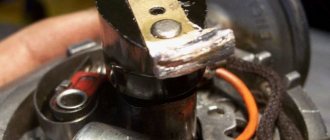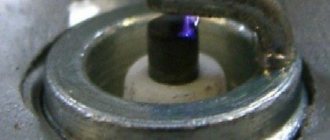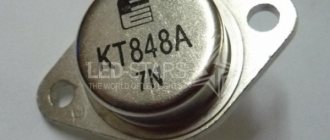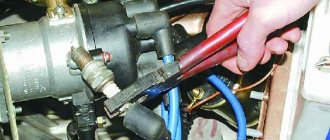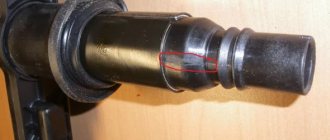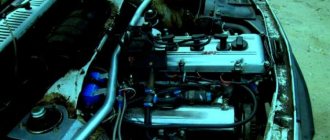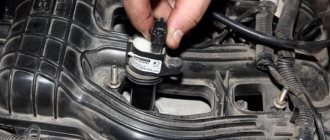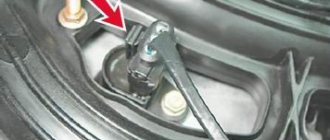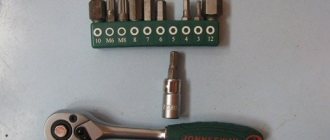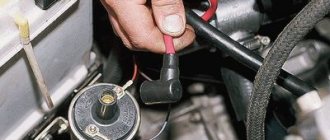The abundance of monitoring and control electronics still does not allow protecting modern injection engines from various malfunctions and problems. Periodically, the engine idles unstable, starts poorly and does not allow you to move away.
You should not always rely solely on electronics, sensors and the car's on-board computer. If, the next time you try to start the internal combustion engine, you clearly hear the fuel pump (pump) working, but the engine itself does not start, you need to check your ignition system to ensure its functionality.
Practice clearly shows that quite often the reason lies in the lack of a spark on the spark plugs. It is with their inspection that experienced motorists and repairmen recommend starting the inspection. Only when deciding to deal with the problem on your own, be extremely careful. There are several methods for checking spark, but each of them requires mandatory compliance with safety rules. Otherwise, you may suffer from an electric shock, as well as damage the car itself.
Main symptoms
The malfunction of these elements can be determined by the nature of the car’s behavior. The main symptoms are difficult ignition, unstable engine operation, floating engine speed at idle. One of the signs of a malfunction is increased fuel consumption. It does not burn in the cylinder because there is no spark. At the same time, the car’s power decreases, since it runs on three (if we consider modern passenger cars) cylinders. Difficulty starting is also the cause of failed spark plugs. The spark may disappear or be completely absent. As a result, the crankshaft rotates, but the ignition power in the remaining cylinders is not enough for its normal operation. Moreover, this occurs even on a warm engine. Sometimes the lack of a spark in one of the cylinders provokes breakdown of the catalyst. The mixture that was prepared and fed into the combustion chamber does not ignite and enters the catalyst, where its elements are oxidized.
How to identify faults
It is not so difficult to determine the performance of the SZ on your own - this can be done both by visual inspection and by analyzing the performance of the engine. One of the main symptoms of an SZ failure is non-standard engine operation. In particular, we are talking about the difficult start of the power unit, its unstable operation, in particular at idle speed.
But besides these symptoms, there are many other signs, which are given below:
- In particular, we are talking about the rotation of the crankshaft. The crankshaft rotates at the required frequency, but the power unit does not start because ignition, i.e., ignition of the air mixture, does not occur in the system.
- Presence of flashes in the cylinders. If flashes of the air-fuel mixture occur in the cylinders, this can lead to unstable engine operation. In particular, the internal combustion engine will work intermittently.
- Poor engine starting. In principle, the engine can start, but if the starter stops working, the engine also stops.
- Increased gasoline consumption. If there is no ignition of the air-fuel mixture, then engine power is either reduced or completely lost. Accordingly, compensation of engine power is carried out as a result of supplying an increased portion of fuel to the cylinders. Ultimately, this leads to excessive fuel consumption.
- Failure of the catalyst. If the system does not ignite, the air-fuel mixture will not be able to ignite. Fuel that does not ignite will enter the catalyst and oxidize, thus contributing to its failure.
- Problems starting a cold engine. At the moment when the driver turns the key in the ignition switch, cold SZ can collect condensation, which in itself is a good electrical conductor. If the gap between the SZ electrodes is increased, the breakdown voltage level should be increased. However, at home it is impossible to increase it, since electricity will flow through these same electrodes and ceramic cone.
- Another, no less important sign is the presence of traces of mechanical damage on the surface of the spark plug. This indicates, if not a complete breakdown, then at least incorrect operation of the SZ, which over time can lead to its failure.
- Presence of soot and deposits on the SZ electrodes. In addition, if the SZ smells of fuel, this indicates a malfunction of the system itself, as well as the spark plugs.
- High-voltage cables on the NW can also contribute to the deterioration of engine performance. Especially if these wires are damaged.
Two SZ - with and without plaque
Spark test
First you need to remove the high-voltage wires. Do this very carefully - sometimes they stick to the contacts. Do not forcefully pull the wire - this will break its insides, which will cause breakdowns. Next you will need a hex spark plug wrench. Depending on the make of the car, it can be of different diameters. When purchasing such a key, be sure to tell the seller the make and model of your car, as well as the size of the power unit. Without this tool, it is simply impossible to unscrew the spark plugs. Having taken the element out, we began to thoroughly clean it of carbon deposits. In general, it should not be on the surface. But before you check the spark plugs yourself, we clean them of all accumulated dirt. The first sign of a malfunction is a large gap between the electrodes. To determine it, you need a special measuring probe. The valve clearances on carburetor cars are measured in the same way. You can buy such a dipstick at any car market.
Stories from our readers
“Fucking basin. "
Hi all! My name is Mikhail, now I’ll tell you a story about how I managed to exchange my two-wheeler for a 2010 Camry. It all started with the fact that I began to be wildly irritated by the breakdowns of the two-wheeler, it seemed like nothing serious was broken, but damn it, there were so many little things that really started to irritate me. This is where the idea arose that it was time to change the car to a foreign car. The choice fell on the melting Camry of the tenth years.
Yes, I had matured morally, but financially I just couldn’t handle it. I’ll say right away that I am against loans and taking a car, especially not a new one, on credit is unreasonable. My salary is 24k a month, so collecting 600-700 thousand is almost impossible for me. I started looking for different ways to make money on the Internet. You can’t imagine how many scams there are, what I haven’t tried: sports betting, network marketing, and even the volcano casino, where I successfully lost about 10 thousand ((The only direction in which it seemed to me that I could make money was currency trading on the stock exchange, they call it Forex. But when I started delving into it, I realized that it was very difficult for me. I continued to dig further and came across binary options. The essence is the same as in Forex, but it’s much easier to understand. I started reading forums, studying trading strategies. I tried it on a demo account, then opened a real account. To be honest, I didn’t manage to start earning money right away, until I understood all the mechanics of options, I lost about 3,000 rubles, but as it turned out, it was a precious experience. Now I earn 5-7 thousand rubles a day. I managed to get the car buy after half a year, but in my opinion this is a good result, and it’s not about the car, my life has changed, I naturally quit my job, I have more free time for myself and my family. You’ll laugh, but I work directly on the phone)) If If you want to change your life like me, then here’s what I advise you to do right now: 1. Register on the site 2. Practice on a Demo account (it’s free). 3. As soon as you get something on the Demo account, top up your REAL ACCOUNT and go to REAL MONEY! I also advise you to download the application to your phone, it’s much more convenient to work from your phone. Download here.
Method No. 2: Spark piezoelectric probe (for example, Test-M) or lighter.
If you don’t have a ready-made device at hand, you can use an element from a piezo lighter instead. The principle of testing is similar: we connect the device to the upper contact of the spark plug and to the body. The button is pressed, if a spark jumps, then the spark plug is working; if it drips or is missing, then it is broken. Details in the video:
Method number 3: Use a multimeter. You should check the electrical circuit of the central electrode by setting the device to 20 kOhm.
If there is “contact” between the central electrode and the tip (shows resistance), then the reason for the lack of a spark may be damage to the insulator. Video example:
Diagnostics without instruments
How to check the spark plugs yourself if you don’t have the necessary testers? Everyone can do this. There is a proven method. But you need an assistant. To do this, unscrew the spark plug and put the high-voltage wire back on it. An assistant turns the starter. At this time, we direct one part of the spark plug to ground - we lean it against any metal part of the engine. It is important that there is no paint on it, otherwise contact will not occur. The spark should be blue.
Two ways to improve spark plugs with your own hands
- Spark plug upgrades are performed only on gasoline engines. One of the common upgrade options is to shorten the electrode, thus opening up the possibility of adjusting the gap. The desired result is to shorten the electrode so that the central one does not overlap with the lateral one, but remains dominant. What is the algorithm of actions?
Spark plug electrode
- Using a simple marker, mark on the electrode the location of the desired cut off of the part.
- Clamps the candle in a vice and continues to adjust the shape of the product.
- Using a grinding machine, we cut off the unnecessary segment that was previously marked.
- We clean the cut-off area with a file suitable for cutting. The goal is to remove unevenness and roughness, and chips.
- We adjust the gap required according to the diagram. The distance depends on the make of the machine and the expected load on it.
- All that remains is to return the upgraded spark plug to the standard seat. And start the car, evaluating the result obtained and realizing whether you managed to professionally solve the problem of how to improve spark plugs with your own hands.
Can it be cleaned?
If there is a characteristic carbon deposit on the electrode and base, this is a sign of engine malfunction. If you simply clean the spark plug and put it back, the carbon deposits will reappear. The color of deposits can indicate many things. This is an incorrectly prepared mixture, the presence of oil in the combustion chamber, etc. By the way, lubricant gets into the cylinder due to existing scuffs or a worn oil scraper ring. Pay attention to this.
Why the spark disappears: the main reasons
On different types of engines, there is a fairly wide list of reasons why there is no spark at the spark plugs. Among the main experts are:
- Problems with spark plugs (destruction of the spark plug body, defects in the electrodes, etc.). It is also worth noting that the spark plugs may be filled with fuel or oil, which indicates a breakdown of the engine itself.
- Malfunctions of high-voltage wires associated with insulation breakdown or lack of contact.
- Failure or errors in the operation of the crankshaft position sensor.
- Problems with the ignition module, ignition coil, switch;
- Malfunctions or malfunctions of the distributor.
- Deterioration or absence of ground contact.
- Errors related to the operation of the electronic engine control unit (ECU);
Principle of operation
Ignition of fuel in an engine occurs using a spark. The coil is used precisely to create such a spark. It is a transformer that converts a weak current into a more powerful discharge. Using a breaker, the contact on the coil opens and a discharge is sent to the spark plug, which ignites the fuel mixture. The gases then push the piston and the engine starts working.
If the current from the coil does not flow to the spark plug, or the discharge does not occur in a timely manner, the engine will operate unstably, lose power at different speeds, or will not start at all.
The coil consists of two windings and a core. The primary winding has from 100 to 150 turns, and the secondary winding has from 5000 to 15000. With their help, the current is converted into a more powerful discharge capable of producing a spark to operate the internal combustion engine.
No spark on an injection engine or an engine with a carburetor: how to check
Checking the spark is possible using several methods: to ground, using a multimeter, or a special tester on a piezoelectric element. The first method is the simplest. The body of the unscrewed spark plug is brought to the metal (usually the engine cylinder block), after which the engine is cranked by the starter and the presence of a spark is analyzed.
Please note that this verification method cannot be used when diagnosing fuel-injected vehicles. The fact is that a car with an injector has an ECU and other electrical equipment that is quite sensitive and can be damaged.
The second method allows you to better assess the condition of the spark plug, identify breakdown, etc. The use of a special tester is a method of checking the spark on injector cars, reminiscent in its principle of checking by analyzing the spark breakdown to ground (the first method). In this case, the risk of burning the control unit is minimized. Now let's talk about how to check the spark on a fuel-injected engine.
A complete lack of sparking indicates possible problems with the controller, ignition module, coil or center wire. Diagnostics should begin by checking the fuses. Then you should evaluate the condition of the ground contact, and also check the high-voltage wires.
If there is no spark at the ignition coil, then the functionality of the high voltage wire should be checked. The specified wire must be checked for insulation integrity, have no breakdowns, burnt areas, etc. Detection of any defects is grounds for its replacement.
Also, in the process of diagnosing the ignition system, you should inspect the spark plugs. This must be done if electricity reaches the candles. On carburetor cars, it is enough to remove the spark plug wire, and then bring it closer to a metal surface (for example, a car body) by half a centimeter. Then you need to turn the starter and make sure that there is a spark running between the wire and the metal surface. The spark itself should also have a certain intensity, be white with a slight bluish tint. If no deviations are noticed, then the spark plugs are working. The reason that there is no spark at the spark plug may be the ignition coil.
If you notice problems with the spark plugs, then you need to pay attention to the spark plug contacts. These contacts must be free of contamination. Let us add that if deviations from the norm are noticed, it is optimal to immediately replace the spark plugs. Failure to do so will indicate the need to clean the contacts.
Where to check spark plugs
For this procedure, auto stores sell vacuum pressure chambers equipped with light indicators. The devices create pressure as in cylinders - up to 15 kg/cm2.
To check the SZ under pressure, replace the high-voltage wire with the cap of the device and press the tip of the device against the cylinder head. Next, you need to press the device key: the blinking indicator will indicate a working glow plug.
However, the tester costs from 2 to 8 thousand rubles, so many motorists use homemade products, for example, constructing a miniature pressure chamber from a 20-gram syringe and a suitable goujon (screwdriver). Others go further: using welding, they make a sealed steel cube with a fitting for the SZ and a tip for injecting air.
Checking the ignition coil for spark
To diagnose the performance of the coil, remove the wire from the distributor-breaker. Next, the test is carried out similarly to testing high-voltage wires, that is, the wire is brought to a metal surface and turned with a starter. The presence of a spark will indicate in this case a problem with the ignition distributor; if there is no spark, then the problem lies in the coil.
First you need to check the distributor contacts. These contacts may oxidize, insulation damage is also possible, and the rotor itself may be faulty. Detecting problems with the rotor allows you to eliminate the problem by replacing it. When checking the ignition coil, you should identify possible defects in the integrity of the winding, burnouts and other signs that a short circuit is occurring inside. If such signs are found, the coil should be replaced or the ignition coil should be repaired.
Now let's take a closer look at ways to check the main elements of the ignition system. To do this, let's go back to the coil. As already mentioned, the most common cause of a malfunction is a damaged winding. Then an insulation breakdown occurs and a short circuit occurs. It is also important to understand that the coil can fail due to overload. Such increased loads occur as a result of problematic spark plugs or spark plug wires. For diagnosis you should:
- put the car in a dry parking, repair or other box. You can also use the garage. The main thing is that the humidity is not too high;
- Next, you will need to clean the distributor cover from dirt, after which the specified cover must be removed;
- then you need to turn the engine crankshaft so that the distributor contacts are closed;
- Now you can turn on the ignition and bring the high-voltage wire of the distributor 3-7 mm to ground;
Other breakdowns and their elimination
If the engine does not start when the ignition is turned on, then, first of all, you need to turn off the ignition system and try to start the engine again after a few seconds. If all this does not give any results, perhaps it makes sense to check the correct installation of the spark plugs - it could very well turn out to be incorrect. If all these actions do not produce any results, then the entire system will have to be thoroughly checked. It may also turn out that the cause of the malfunction is in the distributor cap. It must be carefully dismantled and both sides thoroughly checked. In addition, it is necessary to examine the graphite coal - it could well have been worn off. If the cover is worn out, when its surface is cracked or covered with soot, it is better to replace the cover; it cannot be repaired. The same should be done with graphite coal. Attention! All wiring must be well fixed, because if it comes into contact with other components, its insulation will wear out very quickly. A short circuit can occur due to working fluids getting into the wiring. Therefore, when diagnosing the condition of the ignition system, you should pay special attention to the condition of the wiring. If you find moisture on them, you should definitely wipe it off, because this may well be the reason for poor engine starting. If scratches or other mechanical damage are found on the wiring, it must be replaced. If this is not possible yet, you should wrap problem areas with electrical tape. The ignition coil is checked with an ohmmeter. The resistance must be within the specified range, otherwise the coil will have to be replaced. It is highly not recommended to repair the ignition switch on your own. You can only check the contacts and clean them if oxidation is detected.
It is also worth thinking about the switch, because breakdowns in this unit are quite often the cause of incorrect operation of the ignition coils. The switch is checked with a portable lamp. This is done as follows: the wire that comes from the switch terminal is disconnected from the coil, and then its end is connected to the carrier. The other carrying wire is connected to the coil terminal. Then the ignition is turned on and the car starts using the starter. To do this, the crankshaft will have to be rotated a couple of times. If the light in the carrier lights up continuously, it means that the switch is indeed faulty. Then the problem can only be solved by replacing it. It may also happen that all the wiring is working properly, but the pulses still do not arrive at the switch. Most likely, the contactless sensor is faulty here. It is checked with a voltmeter. This is done as follows: with the ignition off, they begin to carefully turn the crankshaft. In this case, you need to monitor the devices. If the sensor is working properly, then their readings will change sharply. If this does not happen, it can be stated that the sensor is faulty, then it must be replaced. Spark plugs are checked with a “spark”. To do this, you need to remove the wire from the spark plug and bring its end to the ground at a distance of 5-6 mm. After this, you should rotate the crankshaft and look at the gap. If a spark is visible, it means that the system itself is working, and all that remains is to change or clean the spark plugs. During this procedure, it will not be possible to do without an assistant who will have to turn the crankshaft. In this way, the distribution system covers can also be checked. The central wire is disconnected from it, and its end is brought to ground, leaving a gap of 5-6 mm. In this case, you also need to rotate the crankshaft. When a strong spark appears, it can be stated that the circuit is operating normally, and the problem may be in the cover or rotor. It is no longer possible to repair the rotor; it can only be replaced. But if the resistor burns out, the problem can be completely solved with a piece of wire. You can use aluminum and copper wire. A jumper is made from it, which is inserted between the contacts of the router. Of course, this measure is temporary, and you should resort to it only when it is not possible to resolve the issue by installing a full-fledged resistor. For example, this can happen while driving. Do not forget also that a piece of inserted wire causes radio interference, which can spread not only in the cabin, but also near it. The reason for the lack of a spark may also be poor contact of the breaker. Poor contact is quite often the cause of cylinder failure. When checking the contacts, you need to ensure that they are in close contact with each other. Any contamination of the contacts with rust or carbon deposits will certainly reduce the tangent area, and this will certainly cause a complete loss of contact. Sometimes the contacts need to be cleaned non-aggressively. A needle file is used for this. You can clean the contacts with a rag. After cleaning the contacts, rotate the crankshaft until they are completely closed. If any contact does not fit tightly, you need to bend its stand. As you can see, a variety of breakdowns in the ignition system can be eliminated on your own. But if you do not feel completely confident in yourself, then it is better to seek help from specialists who will do everything professionally. Video about checking the ignition system:
Post Views: 1,023
If there is no spark: ignition module
The following symptoms indicate possible problems with the operation of the ignition module:
- at idle speed the engine troits;
- power decreases, the car accelerates poorly;
Engine vibration is most pronounced in two nearby cylinders, and the drop in thrust is more strongly felt during attempts to sharply accelerate the vehicle, that is, when the accelerator is pressed hard and sharply. In such a situation, the “check” light usually lights up on the dashboard of most cars.
If checking the spark plugs and high-voltage wires does not reveal any problems, then the ignition module should be checked with a tester. The test consists of connecting one output of the tester to the module connector, and powering the other to ground. Then the engine can be started. A tester reading of 12 V is evidence that the module is OK. A deviation in the instrument readings from the norm may indicate either the need to replace the module itself or to check/replace the corresponding fuses.
Bringing the car back to life
As for why a spark disappears, everything is probably very clear. Now, it would not be amiss to consider the order of her return. The reality is that in most cases, getting the spark back is a simple matter and just involves carefully checking the broken car. To be more precise, to normalize sparking it is required:
In principle, in theory there are no particular difficulties in repairs of this kind. Despite this, it often causes difficulties in implementation for inexperienced motorists. To solve these, you need to act in the order described above, but if something doesn’t work out, it’s better to turn to professionals at a service station. This approach to repairs will not only save time, but also guarantee trouble-free operation of the car in the future.
Perhaps this concludes the most important information on today’s issue. We hope that the material presented was useful to you and provided answers to your questions. Good luck in operating and maintaining your car!
Source
Useful tips
Experienced car enthusiasts are well aware that spark plugs can fail at the most inopportune moment. For this reason, it is recommended to carry a spare set with you. The same can be said about the spark plug wires.
When working on the ignition system, extreme caution should be exercised as you may receive a severe electric shock. Insulated tools must be used.
Since spark plugs fail more often than other elements of the ignition system, checking for a spark always begins with them. Diagnostics can be done one by one. The procedure is carried out by unscrewing the spark plug from the cylinder head, then putting a cap and a wire from the coil on the spark plug, after which it is grounded to ground. The main indicator when checking while the starter is rotating is the spark itself and its quality.
When removing the spark plug wires from the ignition module, it is advisable to mark each wire. This will allow you to check and subsequently connect in a strictly defined order without the risk of mixing up the wires.
Signs of malfunction and checking injection nozzles without dismantling. Diagnostics of injector power supply, performance analysis. Tips and tricks.
Why does the starter turn normally, but the engine does not catch and does not start? Main causes of malfunction, checking fuel supply and ignition systems. Adviсe.
How to check engine performance using spark plugs. The main signs of engine malfunctions: the appearance of black, gray, red and white carbon deposits on the spark plugs.
Signs of malfunction or breakdown of the high-voltage spark plug wire of the ignition system. How to check car armored wires with your own hands.
Engine trouble: symptoms. Why does tripping occur and how to find the reason why the motor starts to trip. Checking power, ignition, compression, etc.
Selection by model
- Chainsaws
- Spare parts for Chinese chainsaw 45, 52 cc. Cm
- Spare parts for Chinese chainsaws 38 cc.
- Spare parts for Chinese chainsaw 25 cc.
- Spare parts of Chinese Calm 660
- Spare parts for partners 350, 351, 352, 371
- Spare parts for partners 340S, 350S, 360S
- Spare parts for Husqvarna 137, 142
- Spare parts for Husqvarna 230, 235, 236, 240
- Spare parts for Husqvarna 365, 372
- Spare parts for Calm 180
- Spare parts for Calm 210, 230, 250
- Spare parts for Calm 290
- Spare parts for Cali 361
- Trimmers
- Spare parts for Chinese trimmer 33, 43, 52 cc
- Spare parts for Chinese trimmer 26 cm3.
- Spare parts for Husqvarna 125, 128
- Spare parts for Champion T283, T284
How to make a start button instead of an ignition key in a car with your own hands. How to connect the starter
